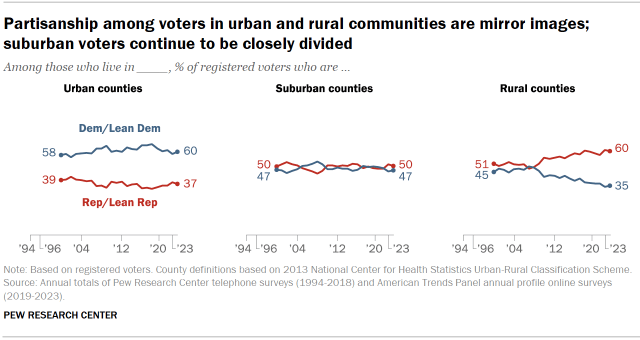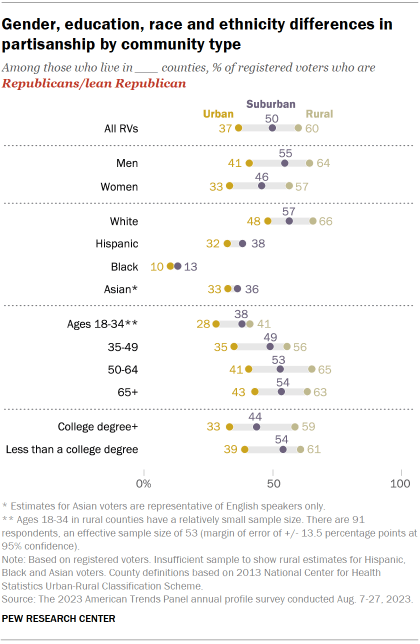Voters’ partisanship has long varied by the type of community they live in. Those in urban counties mostly align with the Democratic Party, while the reverse is true among those in rural counties. In suburbs, where a majority of Americans live, voters’ partisanship is fairly evenly divided.
There have been only modest changes in these patterns in recent years. Over the past two decades, however, voters in rural counties have become increasingly Republican.

- In 2000, the Republican Party held a narrow leaned identification advantage over the Democratic Party among rural voters (51% vs. 45%), but that grew substantially over the next decade. By 2010, the GOP’s advantage had widened to 13 percentage points. It has nearly doubled since then, and the Republican Party now holds a 25-point edge over the Democratic Party.
- The Democratic Party, by contrast, has a nearly identical advantage among voters in urban counties: 60% identify with or lean to the Democratic Party, while 37% identify as or lean Republican. This gap has been relatively consistent over the past two decades, though it is slightly narrower than in 2016 (when 65% of voters in urban counties associated with the Democratic Party and 34% with the GOP).
- By comparison, suburban voters have been closely divided over the past two decades. Half of voters in suburban counties currently align with the Republican Party, while 47% associate with the Democratic Party – identical to the shares who aligned with each party in 2000.
Demographic differences in partisanship by community type
For the most part, the demographic differences in partisanship seen among all voters are evident among those living in different community types.

- Women voters are less likely than men to align with the GOP, and this is evident across urban, suburban and rural counties.
- Younger voters are less committed to the Republican Party than are older voters, regardless of the type of county in which they live.
- White voters in rural counties are especially likely to identify as Republican or lean Republican (66% do so). That compares with 57% of White voters in suburbs and 48% in urban counties.
- Among Hispanic, Black and Asian voters, there is little difference in partisanship between those who live in urban counties and those who live in suburban counties. (Hispanic, Asian and Black rural voters are smaller groups, and sample sizes do not allow for separate reporting.)




